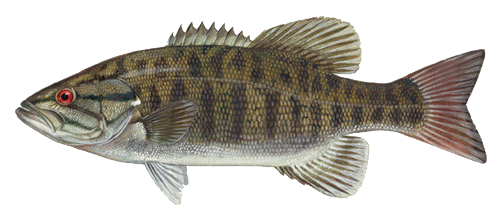| Smallmouth Bass |  |
Smallmouth Bass | | Micropterus dolomieu |
| Key Distinguishing Markings:
- The best characteristic to distinguish a smallmouth from a largemouth bass is the position of the maxillary, or large flap at the posterior end of the upper jaw.
- With the fish's mouth closed, the maxillary will reach, but not obviously extend beyond the eye. Hence the name smallmouth.
- In largemouth bass the maxillary always extends past the back edge of the eye.
- Smallmouth bass are typically brown, bronze, or tan in general color.
- Smallmouth bass also have dark vertical bars which are usually green or gray in color.
- In the largemouth bass you would see dark lateral band.
View the Smallmouth Bass Gallery
| Distribution:
- Smallmouth bass are widespread despite not being native to Maryland waters.
- They were first introduced in 1854 when a B&O Railroad employee transported approximately 20 fish from the Wheeling River in West Virginia to the C&O Canal Basin in Cumberland, Maryland.
- Today they are found throughout the non-tidal Potomac and Susquehanna river watersheds and are common in most of our larger freshwater impoundments.
| Size:
- It requires three to five growing seasons, perhaps six seasons in small streams, for smallmouth bass to reach the legal harvestable size of 12 inches.
| Habitat:
- Smallmouth like cool, clear streams with moderate current, as well as large, clear lakes.
- Preferred habit has a gravel or rubble substrate, boulders, some shade and cover, along with deep pools for stream environments.
| Spawning:
- Spawning occurs from April through June, when water temperatures range from 58 to 70o F.
- Since smallmouth bass are in the Sunfish Family, they are nest builders. The males build saucer shaped nests that are about twice their body length in diameter. The nests may be found on sand, gravel, or rubble with usually a boulder, overhead limb, log, stump, or bank nearby.
- After the adhesive eggs are externally fertilized and laid in the nest, the male assumes guard duty. He fans the eggs to prevent silt deposition, remove metabolic waste, and insure good dissolved oxygen levels.
- The male protects both eggs and newly hatched fry, which are very dark in color, from numerous predators in the aquatic environment.
- Good water quality is essential during and for at least 30 days following spawning to obtain adequate recruitment or a strong year class of smallmouth bass.
- After surviving this critical period the young must avoid predation, usually cannibalization, and grow large enough to endure their first winter.
- Once they become yearlings (one year old), many will remain in the environment to provide good fishing for several years.
| Fishing Tips:
- Smallmouth bass can be caught on a wide variety of live and artificial baits.
- Many anglers prefer the less expensive soft, plastic artificials, grubs and tubes, because lure loss is a certainty when fishing prime smallmouth bass habitat.
- Light spinning tackle is the most popular and least tiresome after casting and catching fish all day.
- Fly fishing is next in popularity, followed by bait casting.
- Dedicated smallmouth bass anglers practice catch-and-release tactics.
- Smallmouth bass in non-tidal waters are protected from harvest by a statewide closed season which extends from March 1 thru June 15 each year.
- Most waters have a five fish daily creel limit and legal harvestable size of 12 inches for smallmouth bass.
- Some waters have either trophy slot or catch-and-release regulations.
- For current recreational size and creel limits, see Maryland's updated regulation page.
| Fun Fact:
| | Family: Centrarchidae(Sunfishes) | | Order: Perciformes (perch-likes) | | Class: Actinopterygii (ray-finned fishes) | For information concerning smallmouth bass and their management, please contact John Mullican at 301-898-5443.
Illustration courtesy of Duane Raver, USFWS
|
|
